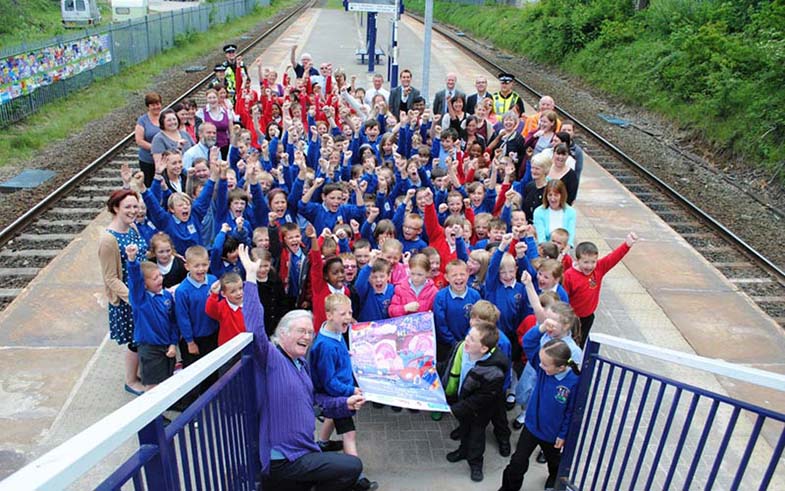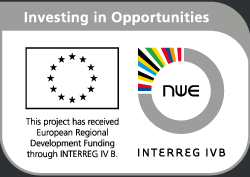By working with schools you can instill a life-long love of rail travel among children (and their families) who may previously have never travelled by train. As well as directly increasing rail usage, school projects can:
- Keep kids safe, thanks to rail safety sessions
- Reduce vandalism and graffiti
- Help families to spend quality time together
- Persuade schools to use the train for future excursions
There is a balance to be struck between instilling rail safety messages and getting children inspired about travelling by train – but by being creative there is room to achieve both.

Inspiration

Passport to Safe Rail Travel
Lancashire (UK)
As part of this award-winning project by Community Rail Lancashire, school children receive more than six hours of education about rail history, use of timetables, safe travel and railway related safety issues. They then receive a “passport” giving them free travel on off peak services for three months, on two specified routes, when accompanied by an adult.
The scheme has resulted in 50% of the children taking a train trip with their family, many for the first time ever. The concept is now being emulated in Devon and France as part of the Citizens’ Rail project.
Read more.

School engagement with SNCF
Pays de la Loire (France)
SNCF, France’s state-owned national railway company, has a strong commitment to engaging schools and colleges across the country, reaching more than 230,000 pupils each year through classroom sessions and free resources for teachers. Locally in Pays de la Loire it has 15 staff trained and certified to work with schools.
In an exciting development, Région Pays de la Loire is now working with SNCF on a new school group ticket. The foundations for the project included market research with schools to discover how they choose, plan and design their school excursions – so that the new ticket can meet their needs. Read more.

Eilendorf art project
Aachen (Germany)
Local school children have given Aachen’s Eilendorf station a whole new look – and grabbed the media spotlight in the process. Aachen City Council ran a competition with a school called Maria Montessori Gesamtschule Aachen to produce designs to brighten up the station’s shelters, noise reduction wall, entrance and signage.
The children visited the station to take a look for themselves and get inspired. They then produced a wide range of concepts, from which the winners were picked by a panel of judges from the City Council, the school, Deutsche Bahn and other project partners.
The students then returned to the station armed with paint and brushes to make their designs a reality. Their efforts were featured on local TV news and were saluted on the front page of their free local newspaper, distributed to every household in the city.
Read more.
What you can do

Station tours – Give pupils a behind-the-scenes look at their local station. For example, on visits to Blackburn station in the UK, two lucky children get to make the train announcements over the public address system.
Classroom work – Academic work can happen either in school or at the station if you have a dedicated classroom, like the ones at Accrington station’s “bunker” or at Burnley Manchester Road. Activities should be tailored to the school curriculum, and could include:
- DVDs – Use characters like Community Rail Lancashire’s Brian the Bull (pictured) and create a DVD about your line. Show it to pupils and follow it up with a question and answer session.
- History – Let the children wear and handle old railway equipment like signals, uniforms and oil lamps, as part of learning about local history and lives from the past.
- Maths – Create activities based on timetables, journey times and distance, or get pupils to collect data using tally marks and graphs.
- Art – Ask the children to design a rail safety poster, or use railway lines in the landscape to teach how to draw or paint with perspective.
- Literacy – Use rail-related poetry and stories like “The Railway Children” as a starting point for activities.
- Design – Design a train for the future, or do a project on railway bridges or other infrastructure.
- Geography – Compare and contrast the scenery in rural and urban areas of your line.
- Citizenship – Consider why we have rules in society, and the environmental impact of our travel decisions.
Hear from people who’ve done it
In this video Brian talks about one project in particular – the story of how children from Padiham Green CE Primary School created a rail history play and cultural presentation to welcome Citizens’ Rail partners to Burnley Manchester Road station.
The European visitors were so impressed that an international trip was arranged, with the Padiham pupils visiting two of the Citizens’ Rail partner regions, Aachen (Germany) and Heerlen (the Netherlands).
How to make it happen
Sell the idea to your rail operator. School trips are great examples of Corporate Social Responsibility, and make business sense by cultivating future customers. If you can negotiate free school trips with them, it will be easier to get teachers interested.
The other key to attracting schools is to make rail fit into the curriculum. Be flexible and creative. Consider what your line has to offer – from history or geography, to maths or literature. Community Rail Lancashire have lots of ideas to get you started.
Prioritise which local schools to work with. A starting point may be to look at those located closest to stations. Having a keen headteacher is crucial, as it will make everything easier.
Once you are running school activities, maximise their impact by encouraging pupils to travel again with their whole family. Give children leaflets and other materials to take home to make it easy for them to get their parents on board.
You can make your educational programme stronger, more varied and more interesting by working with partner organisations. For example, in the UK consider collaborating with the British Transport Police.
Once you have some successes under your belt, use these as examples to help convince other schools to get involved. Use quotes from the headteacher and if possible statistics showing how many children continued to use the train.
Resources
Links to useful materials around the web:
- Curriculum links (PDF)
Diagram by Community Rail Lancashire showing how rail can fit into the UK’s Key Stage 2 National Curriculum. - Teachers’ packs (webpage)
Read a pair of teachers’ packs developed by Community Rail Lancashire.
Contribute

If you have your own case studies, resources or ideas to contribute to this (or any other) section of the toolkit, please get in touch.
Email our lead partner DCRP or call +44 1752 584777 to speak to our lead partner, the Devon & Cornwall Rail Partnership.
More from the toolkit
Site map
Toolkit homepage | Why get involved? | Contacts for volunteers | How the rail industry works
Improve existing stations
– Early consultation
– Designing with students
– Art and gardening projects
– Community-focused buildings
New uses for station buildings
Creating new stations
More trains, better stations
Attracting more users
Involving citizens and stakeholders








